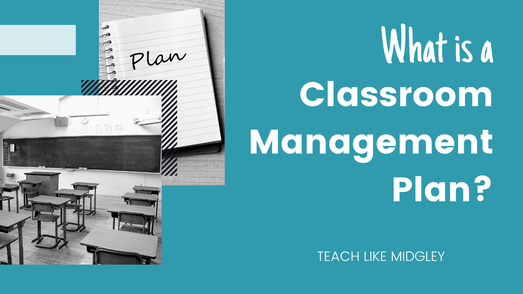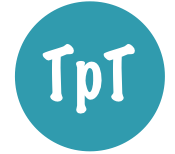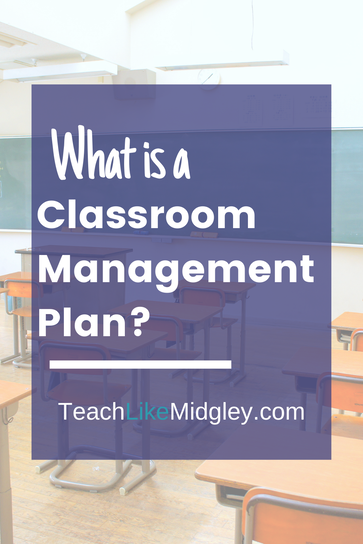What is a Classroom Management Plan?
What exactly is classroom management?
It seems to be a topic that is used a lot in connection to good teaching. And it is, for I have never encountered a teacher with high performing students who did not have amazing classroom management skills.
But there also seems to be confusion over what the term classroom management actually means. And this confusion can make it difficult for teachers to achieve these skills.
It seems to be a topic that is used a lot in connection to good teaching. And it is, for I have never encountered a teacher with high performing students who did not have amazing classroom management skills.
But there also seems to be confusion over what the term classroom management actually means. And this confusion can make it difficult for teachers to achieve these skills.
Here is the definition of classroom management, according to The Glossary of Education Reform:
Classroom management refers to the wide variety of skills and techniques that teachers use to keep students organized, orderly, focused, attentive, on task, and academically productive during a class. When classroom-management strategies are executed effectively, teachers minimize the behaviors that impede learning for both individual students and groups of students, while maximizing the behaviors that facilitate or enhance learning.
It is easy to see where the confusion lies, since the outcome of strong management skills usually results in a low number or even zero behavioral problems, many tend to think a classroom management plan is in fact their class rules and consequences.
However, a teacher’s rules and consequences are a discipline plan, which is different from a management plan.
Classroom Management Styles
Simply put, your classroom management plan consists of the routines and procedures that are key to running a smooth, successful, academically focused classroom.
These routines and procedures should fit your needs as a teacher and the needs of your students. Whatever action is taking place in the classroom, there needs to be a procedure for it.
Some examples include:
+ Classroom Entry Routine
+ Do Now Activities
+ Transitions
+ Nonverbal Intervention
+ Supply Distribution
+ Partner Work
+ Small Group Work
+ Technology Procedures
+ Independent Work Time
+ Submitting Homework/Classwork
Your routines and procedures are clear directions for your students about how to learn in your classroom.
The best resource out there that I would recommend above all others is The Classroom Management Book by Harry Wong and Rosemary T. Wong.
These routines and procedures should fit your needs as a teacher and the needs of your students. Whatever action is taking place in the classroom, there needs to be a procedure for it.
Some examples include:
+ Classroom Entry Routine
+ Do Now Activities
+ Transitions
+ Nonverbal Intervention
+ Supply Distribution
+ Partner Work
+ Small Group Work
+ Technology Procedures
+ Independent Work Time
+ Submitting Homework/Classwork
Your routines and procedures are clear directions for your students about how to learn in your classroom.
The best resource out there that I would recommend above all others is The Classroom Management Book by Harry Wong and Rosemary T. Wong.
Classroom Management and Discipline
A good classroom management plan will have a positive effect on the level of discipline you deal with in the classroom.
I taught one student, we’ll call him Ricky for purposes of this story, who seemed to always be in trouble.
He often found himself sitting in the office, waiting to see the assistant principal.
One day, the AP was nearing the end of his patience and understanding what was going on with this kiddo. He looked at Ricky, and asked:
“Ricky, every single one of your teachers has sent you to my office multiple times because of your behavior choices. Every teacher except one, Mrs. Midgley. Why is it that you haven’t had any issues in Mrs. Midgley’s class, but you have with every other teacher?”
Ricky looked at the AP and said with all seriousness, “Because you just don’t do those things in Mrs. Midgley’s class. You go to Mrs. Midgley’s class to learn. And I learn in her class every day.”
The AP and I had a long interesting talk, where he shared this conversation with me. He wanted to know what I was doing, how I was doing it, and what other teachers were doing differently.
I taught one student, we’ll call him Ricky for purposes of this story, who seemed to always be in trouble.
He often found himself sitting in the office, waiting to see the assistant principal.
One day, the AP was nearing the end of his patience and understanding what was going on with this kiddo. He looked at Ricky, and asked:
“Ricky, every single one of your teachers has sent you to my office multiple times because of your behavior choices. Every teacher except one, Mrs. Midgley. Why is it that you haven’t had any issues in Mrs. Midgley’s class, but you have with every other teacher?”
Ricky looked at the AP and said with all seriousness, “Because you just don’t do those things in Mrs. Midgley’s class. You go to Mrs. Midgley’s class to learn. And I learn in her class every day.”
The AP and I had a long interesting talk, where he shared this conversation with me. He wanted to know what I was doing, how I was doing it, and what other teachers were doing differently.
Classroom Management Philosophy
At the time I wasn’t spending a lot of time in other classrooms, just my own. So all I could really share were my own methods.
I explained to him how I had expectations of myself and my students. There were procedures for everything. Every activity had clear directions, and I answered any and every question my students asked, so they would clearly know what to do.
I also did a lot of modeling for students, which is my #1 suggestion when it comes to integrating learning skills into daily curriculum. This allowed to better understand my expectations, what they were supposed to do, and what it looked like.
And when it came time for students to do the work, I provided the support where it was needed, for the students who needed it.
My students knew I was there for them, and that I would do anything to help them. But they also knew I would make them think for themselves and do the work. They knew I believed in them and that they could do it. So, they did it.
I explained to him how I had expectations of myself and my students. There were procedures for everything. Every activity had clear directions, and I answered any and every question my students asked, so they would clearly know what to do.
I also did a lot of modeling for students, which is my #1 suggestion when it comes to integrating learning skills into daily curriculum. This allowed to better understand my expectations, what they were supposed to do, and what it looked like.
And when it came time for students to do the work, I provided the support where it was needed, for the students who needed it.
My students knew I was there for them, and that I would do anything to help them. But they also knew I would make them think for themselves and do the work. They knew I believed in them and that they could do it. So, they did it.
Classroom Management Plan
In teaching you can’t just talk the talk, you must also walk the walk. The do as I say, not as I do expression has no place in the classroom.
Give your full commitment to your students, and they will give you theirs in return.
I run my classroom with 22 procedures and a very simple discipline plan.
If you are interested to know more about it, check it out here: my personal Classroom Management Plan. Perhaps you will find it helpful to use as a guide to creating your own plan with the provided template.
Give your full commitment to your students, and they will give you theirs in return.
I run my classroom with 22 procedures and a very simple discipline plan.
If you are interested to know more about it, check it out here: my personal Classroom Management Plan. Perhaps you will find it helpful to use as a guide to creating your own plan with the provided template.
This post was originally written by Hillary Midgley and published at Study Skills Unleashed
You Might Also Like...
Let's Connect...

Welcome! I'm Hillary Midgley, a veteran 6th grade teacher.
I create educational materials and develop curriculum for other teachers. I specialize in teaching students how to learn through my Study Skills Curriculum. I have established fundamental classroom systems and structures for teachers to help them streamline their classroom. And my passion is teaching ancient history through engaging activities with foundations in academic skills. Here you will find resources on all of these topics and more. Learn more about me here.
|






